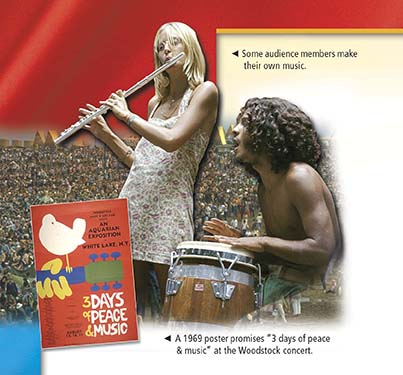SECTION 1: The Counterculture
WITNESS HISTORY  AUDIO
AUDIO
Remembering Woodstock
In the summer of 1969, hundreds of thousands of people gathered for a rock concert in Bethel, New York. Most of the media criticized the three-day event because of the concertgoers’ widespread use of drugs and open displays of “free love.” The people who went to Woodstock felt differently. For them, Woodstock showed that close to half a million people could come together peacefully. Twenty-five years later, many who attended Woodstock still remember their experiences vividly.
“Woodstock was a time of social changes in human freedom and expression…. We learned not to be ashamed of our bodies…. We spent time with our kids…. That festival set the standards for peace, music, people and expression and showed to the world that all was not just violence and hatred … it was LIFE!”
—Juan C. Morales
Objectives
- Describe the rise of the counterculture.
- List the major characteristics of the counterculture.
- Evaluate the impact of the counterculture on American values and society.
Terms and People
- counterculture
- generation gap
- Beatles
- commune
- Timothy Leary
NoteTaking
Reading Skill: Identify Main Ideas As you read, use a concept web like the one below to record main ideas about the counterculture.

Why It Matters Woodstock was a dynamic expression of a counterculture that arose in the 1960s. Members of the counterculture adopted values that ran counter to mainstream culture. They rebelled against long-standing customs in dress, music, and personal behavior. The counterculture both challenged the values of mainstream American society and unleashed a movement to reassert traditional values. Section Focus Question: What was the counterculture, and what impact did it have on American society?
The Counterculture Rises
The counterculture was rooted in the social and political events of the 1950s. The Beat movement had emphasized freedom from materialism and the importance of personal experience. The civil rights movement introduced the idea of social and political protest, which stimulated the Vietnam antiwar movement. Both movements prompted many people to question traditional boundaries, whether restrictions on rights or cultural norms in dress or hair-styles. It also heightened distrust of authority, leading some in the counterculture to declare, “Don’t trust anyone over 30.”
Members of the counterculture valued youth, spontaneity, and freedom of expression. Also called hippies, these young people promoted peace, love, and freedom. They experimented with new styles of dress and music, freer attitudes toward sexual relationships, and





